Disclaimer: This product was sent to us for free in exchange for a review. That does not affect our opinion about the product, in this article we list both what we like and dislike. Read more about this here.
Review Of The LiTime 12V 100Ah Lithium Battery
LiTime (formerly Ampere Time) is a company that is gaining more and more ground as a lithium battery manufacturer.
They reached out and wanted me to review their 100Ah model. I have heard good things about this company and this battery specifically, so I agreed to do it.
Related Post: Best Portable Solar Panel Chargers For RVs/Vandwellers
It’s currently on sale for $269 over at LiTime.com and if you use the code thecampingnerd you will get an extra 3% off. It’s hard to believe that you can buy a good 100Ah lithium battery for less than $270.
It’s also available on Amazon.com, you can click on this link to see the current price.
Let’s get right into it by taking a look at what the LiTime battery is rated at, then I will share my test results.
Can it be as good as they say, even though it only costs a little more than my current 100Ah AGM battery?
LiTime 12V 100Ah Specifications
Battery Cells
LiTime use the lithium iron phosphate (LiFePO4) cells, which have a reputation of being both durable and safe.
According to the YouTube channel Lithium Solar’s teardown video, the specific cell used is the prismatic cell type.
Since there is no protection against low temperatures on this model, it’s important to be aware of the working temperature range.
Charging: 32°F to 122°F (0°C to 50°C)
Discharging: -4°F to 140°F (-20°C to 60°C)
Storage: 14°F to 122°F (-10°C to 50°C)
Charging, discharging, or storing the battery outside of these temperature ranges can cause permanent damage.
Ratings – Ampere hours (amp hours) and watt-hours
The battery is rated at 100Ah, which is 1280 watt-hours at 12.8V.
100Ah is also the max continuous charge/discharge current, which means that it can output up to 1280W. As I’ll show in my test results it can put out more than this, but 100Ah is what it’s rated at.
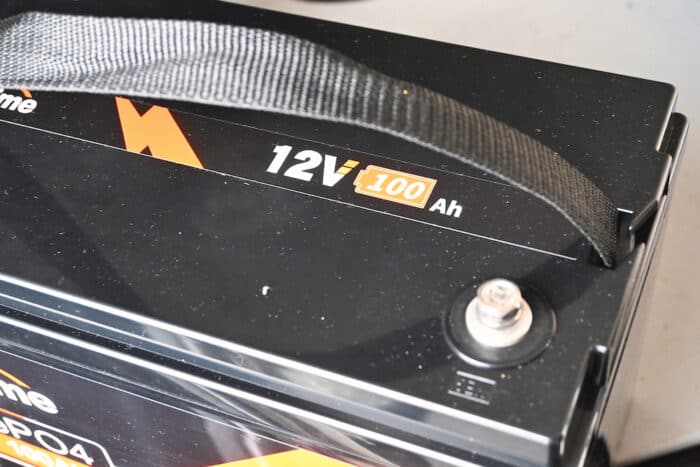
So does this mean that it will last one hour if you max the continuous load? No, unfortunately it’s not that easy with batteries so you should always overestimate when calculating how much electricity your devices are going to use.
The SOC (state of charge) can be can be roughly estimated by the resting voltage, the numbers below are from the manual.
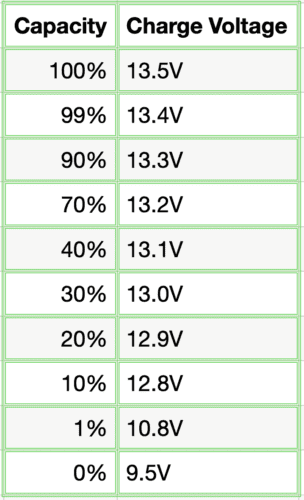
Safety features with built-in BMS
BMS is short for Battery Monitoring System.
The BMS is there to protect and prevent overcharging, over-discharging, overcurrent, and short circuits.
Not all lithium batteries like this have a built-in BMS, especially not the cheap ones, and it can cause permanent damage if you use the battery without one.
Cycle life
LiTime advertises that this battery will provide more than 4000 deep cycles over 10 years.
The battery will still work after that many cycles, but it might only charge to 80% of its original capacity. It’s impossible to say exactly since there are a lot of factors in play.
The estimated life cycle of LiFePO4 batteries is one big reason to consider lithium over the more common lead-acid.
They’re usually rated for 500-1500 cycles, and should not be discharged completely which requires more monitoring.
One easy way to extend the life cycles is to not discharge the battery completely unless you have to. If you don’t discharge it past 50%, it might last 10,000 cycles. Again, take the estimates with a grain of salt.
Expandability
If you would like to expand the total capacity of your setup, you can connect up to 16 batteries together in a 4S4P configuration.
If this is something you would like to do, I recommend researching how it’s done and what you need to know.
Design and what’s included
Its case is made out of ABS plastic, which is a very strong and durable plastic.
The battery has an IP65 rating. That means that it has enough protection to handle dust and low pressure water jets like light rain.
It’s not recommended to leave it out and exposed to the elements for very long though, for several reasons.
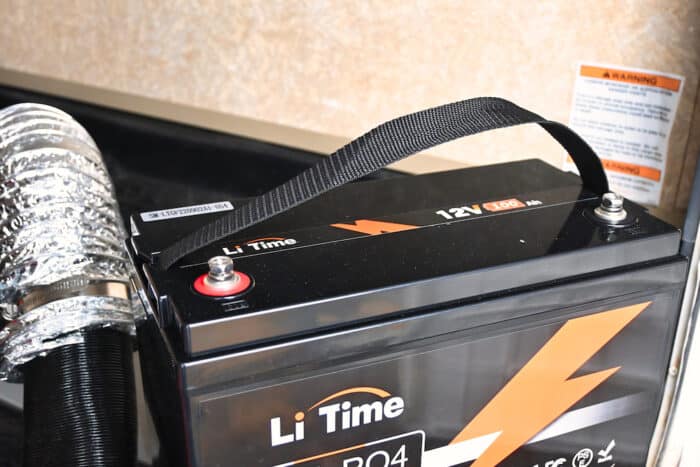
The built-in strap handle on top makes it easy to carry the battery.
Both the positive and negative terminals are located on top of the battery, which is the standard with these type of batteries.
Four M8 bolts are included, two are screwed into the terminals.
Size and weight
The battery measures 13 by 6.77 by 8.43 inches (32.9 by 17.2 by 21.4 cm).
It weighs 24.25 pounds, which is almost exactly 11 kilograms.
Review And Test Results
Now that we know the in and outs of the battery, here are my likes and dislikes.
What I Like
A lot of amp hours for the money
The current price over for this battery over at litime.com is $349 before tax.
If you would have told me a couple of years ago that I will be able to buy a reliable 100Ah LiFePO4 battery with a built-in BMS for $349, I would’ve said “no way”. But here we are.
After testing this battery and pushing it to its limits, my opinion is that it’s a great battery at an affordable price.
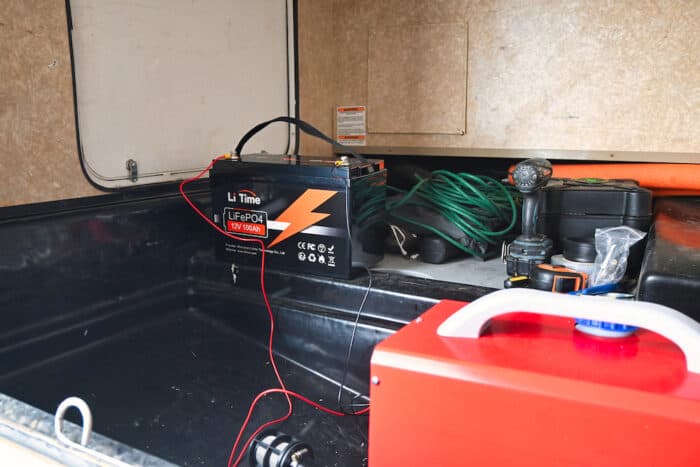
When I ran a battery capacity test with a discharge current of 4A (close to 50W), I got four more Ah out of it than the rated 100Ah.
In watt-hours that is 1331Wh.
I was able to exceed the maximum continuous load
While it does have a max output rating of 100A (1280Wh at 12.8V), I was able to pull close to 2000W. If I went over 2000W, the BMS eventually intervened and my inverter shut down.
You should not do this though, as there are reasons for the listed limit.
Built-in BMS
As I mentioned earlier, not all lithium batteries have a built-in BMS.
It’s always recommended for safety reasons, and it’s great that LiTime was able to include it at this price point.
So much lighter than a 100Ah lead-acid battery
This is almost always the case if you compare a lithium battery against a lead-acid with the same capacity rating, but I want you to understand how big the difference really is.
The 100Ah AGM battery I use in my RV weighs 68 pounds, the LiTime lithium battery weighs less than 25 pounds. That is a 43 pound difference.
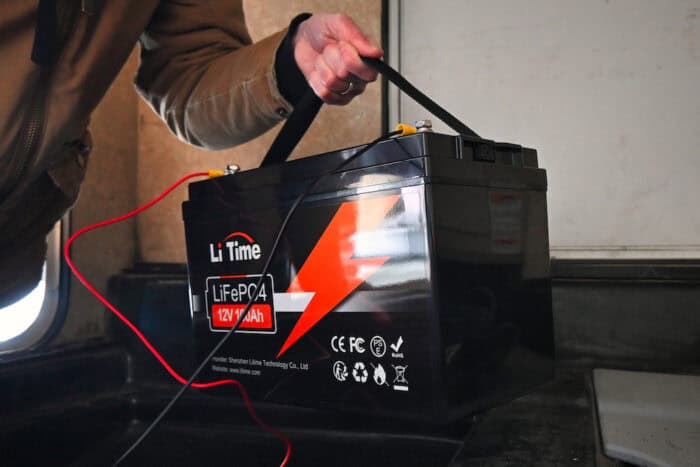
Imagine the total weight difference if you have four, or sixteen batteries. If you’re traveling in an RV or camper van, the weight is always something to consider.
The durability of LiFePO4 batteries
As I have talked about throughout this post, lithium iron phosphate batteries are not only lighter than lead-acid batteries but also more durable.
Durable in the sense that it can handle a lot more cycles and not degrade as fast.
The initial cost of lithium batteries might seem high, but at the prices we’re seeing these great LiFePO4 batteries there is almost no reason to buy lead-acid.
Sure, it might require an upgrade to your RV converter charger and not be as capable in low temperatures, but the pros outweigh the cons in my opinion.
What I Don’t Like
No built-in heating or low-temperature protection
This model does not have any safety features that will heat or prevent damage from charging/discharging/storing the battery in too cold or warm temperatures.
That makes it extremely important to be aware of what those ranges are.
Charging: 32°F to 122°F (0°C to 50°C)
Discharging: -4°F to 140°F (-20°C to 60°C)
Storage: 14°F to 122°F (-10°C to 50°C)
LiTime does make a model that can heat itself up, but the model I reviewed does not.
Frequently Asked Questions
Should I switch to or use lithium batteries in my RV/power station?
I think it’s worth switching to lithium if you are a full-timer with an inverter that can take advantage of the things lithium does better than lead-acid.
Like the faster charging and discharging, and not having to worry that a full discharge will cause as much permanent damage as it would’ve with a lead-acid.
If all the RV battery does is power lights, fans, and a 12V TV, it might not be worth it.
When it comes to homemade power stations I would never use anything but LiFePO4 batteries. The life cycles, weight, charging/discharging rates, and the overall safety are the main reasons.
As the cost of lithium has fallen in the past year or so, more companies have jumped on the bandwagon and that has been both good and bad for us customers.
The good is that there is more competition and options, but the negative is that some companies are selling right out dangerous products or lies about what their batteries are capable of.
It reminds me of the hoverboard era where some were really good, but the news couldn’t start talking about the ones that caught fire.
Guess what the main reason was behind a lot of those fires? Bad lithium batteries that overheated.
Can I replace my RV camper battery with a lithium battery? Is it a drop-in replacement?
Before replacing your RV battery with a lithium battery, or even before a purchase is made, you should make sure the converter charger in your RV supports lithium batteries.
The more typical lead-acid battery that your RV most likely has right now charges a little bit different than a lithium battery.
It can damage the battery if a converter charger thinks it’s charging a lead-acid type but it’s connected to a lithium battery.
You can figure out what it supports by reading the manual. If you don’t have it anymore, look at the converter charger for a model number then Google the manual for it.
How do I charge the battery?
There are several ways to charge a 12V battery, but you need to make sure that the charger you use supports lithium batteries.
Battery charger – LiTime makes 12V battery chargers in different sizes, here is their 20A lithium charger for example.
A 20A charger will recharge an empty 100Ah battery in five hours.
Solar – If you have solar panels with a solar charge controller set to 12V, you can connect the battery directly to the charge controller.
Make sure it supports lithium batteries, not all charge controllers do.
Converter chargers in RVs/campers – If you have an RV with a 12V battery, you most likely have a converter charger.
The converter charger is what charges the 12V RV battery when you plug in your RV at home, at a campground, or to a generator.
If the converter charger in your RV supports lithium and it’s a 12V system, you can replace the old battery with a LiTime 12V lithium battery.
There are more ways to charge a battery, and if you have questions about other way please leave a comment.
What inverter should I use with this battery?
The battery is rated for up to 1280W output, but I recommend getting at least a 1500W inverter so there is some headroom if you are going to get close to the max output.
However, as I found out when I tested the battery it was able to output more than 1500W without a problem. So it won’t hurt to go with a 2000W or larger inverter.
I don’t recommend exceeding the 100A output rating, but the BMS in the battery will turn off the output if it’s about to damage to the battery.
Is it waterproof?
With its IP65 rating it’s water-resistant, but it’s not waterproof.
Do not leave it out for an extended period of time if if it’s raining.
Can I use solar panels to recharge the LiTime battery?
Absolutely, LiTime recommends charging with at least 300W 12V solar panels.
In ideal conditions, that would be enough to recharge the battery from 0 to 100% in five hours.
Please leave a comment down below if you have questions.


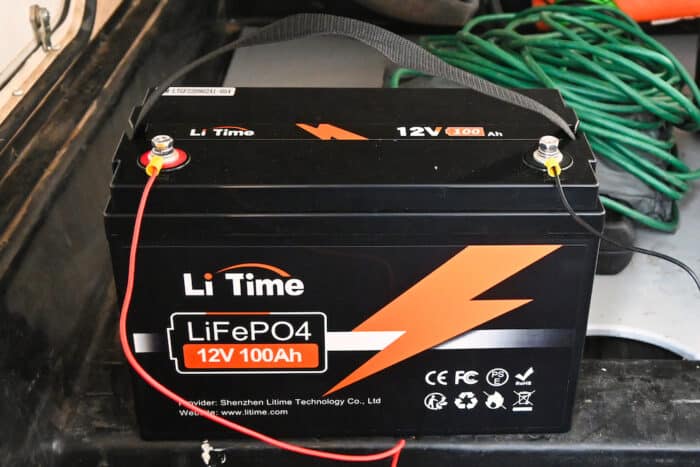
lfp does NOT responds like a lead battery to the peukert formula . The influence is negligible.
Thanks for letting me know that, I will update the post.
Thanks for doing this I like it
Down to earth explanation
I am buying 2 each 100ah
Hi:
How does this battery perform to power electric trolling motors on a small fishing boat? Joe M.
You stated using a 300 watt solar panel. My rv is equipped with only 250 watts of solar power is this a problem?
Hi,
That is totally fine!
having a BMS thst the end user cannot adjust is bad. often the charging voltages set by manufacturers are way to high for good battery life. Not knowing the BMS settings is also poor. You need to set up your solar charging such that it turns off once the batteries are full, not when the BMS decides to switch off. The BMS is the last ditch solution for safeguarding the battery cells, not the charging control device. Cells should be charged to 3.5v per cell, so a maximum of 14v. charging higher stresses the cell for very little gain. if the BMS cannot be adjusted to do this, then walk away from this type of battery